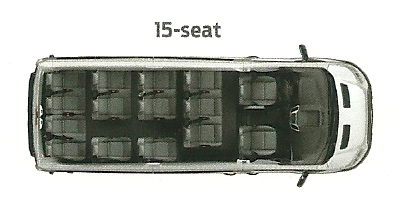
#Ford transit wagon 15 passenger series
The FK series was successor of the "Rhein" and "Ruhr" trucks. In 1951 Ford Werke AG launched the FK commercial vehicle series, FK standing for Ford Köln, with different-sized vehicles (FK2000 with 2 tons payload, FK3000 with 3 tons payload, FK3500 with 3,5 tons payload, etc.). With this, Ford of Britain and Ford-Werke AG suddenly became more competitive on the whole European Continent than local market subsidiaries of their parent company in Detroit. Īfter the war, several economical boundaries were abolished and local markets did not exist anymore in the same way that they existed before.

Just as Ford also had to comply with the type restrictions of the Schell-Plan, which were introduced in March 1939 in anticipation of the war. Until Germany declared war on the US in December 1941, almost half of the shares of the Ford-Werke AG were in German hands, as well as its production sites were managed by the Reich Commissioner for the Treatment of Hostile Property - Johannes Krohn. Those trucks were now called "Rhein" and "Ruhr".Īt that time neither Ford of Britain nor Ford Werke AG were 100% subsidiaries of Ford Motor Company in Detroit and before the Second World War each company had its own more or less protected market. Those trucks based on the slightly modified war models V 3000 S, B 3000 S und V 3000 A as they were already produced before and during the Second World War in the Ford production facilities in the Third Reich. Because the production of civilian cars in the occupied zone was reserved for the British (for instance for Ford of Britain), Ford-Werke AG limited itself to the production of trucks (until 1948). On May 9, 1945, the day after the unconditional surrender of the German Wehrmacht in the Second World War, production at the German Ford-Werke AG in Cologne (Köln) resumed. ( November 2019) ( Learn how and when to remove this template message) Please help improve it by rewriting it in an encyclopedic style. This section is written like a personal reflection, personal essay, or argumentative essay that states a Wikipedia editor's personal feelings or presents an original argument about a topic. That mirrors the success the Transit has achieved in Europe, where it has been the best-selling light commercial vehicle for forty years, and in some countries the term "Transit" has passed into common usage as a generic trademark applying to any light commercial van in the Transit's size bracket. Upon its introduction in North America, the Transit quickly became the best-selling van of any type in the United States, minivan sales included. By the end of the twentieth century, it was marketed nearly globally with the exception of North America until 2013 when it replaced the Ford E-Series van. The first product of the merged Ford of Europe, the Transit was originally marketed in Western Europe and Australia.

As of 2015, 8 million Transit vans have been sold, making it the third best-selling van of all time and has been produced across four basic platform generations (debuting in 1965, 1986, 2000, and 2013 respectively), with various "facelift" versions of each. The vehicle is also known as the Ford T-Series (T-150, T-250, T-350), a nomenclature shared with Ford's other light commercial vehicles, the Ford F-Series trucks, and the Ford E-Series chassis. The Ford Transit is a family of light commercial vehicles manufactured by the Ford Motor Company since 1965, primarily as a cargo van, but also available in other configurations including a large passenger van (marketed as the Ford Tourneo in some markets since 1995), cutaway van chassis, and a pickup truck.


 0 kommentar(er)
0 kommentar(er)
